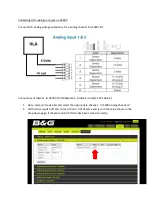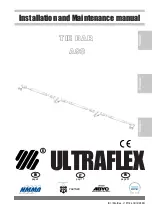
Operation
These settings create the maximum flow of sample gas through the gas cell, pulled through by
the diaphragm pump. With everything wide open, the pressure gauge reading will be at or
near atmospheric pressure, typically 730-770 mmHg (approximately 1 bar).
c. Gradually close the FTIR Inlet Restrict valve until the gas cell pressure begins dropping to
the target 650 mmHg. Note that each time you adjust the needle valve, there will be a delay in
response as the pressure/flow adjusts all the way to the sample chamber.
d. When the pressure stabilizes in the 650 mmHg range, adjust the FTIR Flow To Vent
flowmeter to set the desired flow rate to 4 lpm.
Note Adjusting this flowmeter restricts the vacuum generated by the diaphragm pump, so
the target pressure will likely rise.
Note the Calibration Flow flowmeter iis not part of the flow path from the sample chamber
through to the vacuum pump, so it does not affect the adjustments from the Open Sample
path.
e. Once the flow rate is stable at 4 lpm, fine tune the pressure in the gas cell using the FTIR Inlet
and Outlet restrictor valves to balance the flow. This procedure can be somewhat difficult at
first, but with some practice you will be able to adjust the pressure to a stable value near 650
mmHg.
f. The pressure transducer feeds the actual gas cell pressure to the OMNIC or RESULT
software, where it is used to adjust for any drift away from 650 mmHg. Therefore, it is not
required to set the pressure perfectly to 650 mmHg; the software will precisely adjust for
variations in pressure within a +/- 25 mmHg range.
3. Prepare to collect a Background (zero) spectrum before start of sample collection.
a. Turn the input from the Heated Transfer Line (HTL)(the sample control valve) to Close
Sample.
b. Turn the calibration gas selection valve to N2 to begin flowing N2 (or clean filtered,
compressed air) through the FTIR gas cell and sampling system.
The pressure and flow values set up in the previous section are based on the pressure in the
sample gas chamber being at or near ambient atmospheric pressure, with a pressure drop
across the (optional) soot filter and through the length of the Heated Sample Line (HSL).
The N2/Compressed Air line, in contrast, does not flow through the soot filter or HSL, and it
will have positive pressure that pushes the gas through the ModGas system. This “push” of
54
Modular Gas System User Guide
Thermo Scientific
Summary of Contents for FTIR
Page 1: ...Modular Gas System USERGUIDE 269 346401B July 2022 ...
Page 15: ... This page intentionally left blank ...
Page 38: ...using the pressure transducer Thermo Scientific Modular Gas System User Guide 33 Installation ...
Page 61: ... This page intentionally left blank ...
Page 79: ... This page intentionally left blank ...
Page 82: ...Eductor Panel Thermo Scientific Modular Gas System User Guide 77 Plumbing diagrams ...
















































